Galleries
An Introduction to Joan Miró
Joan Miró was a complex and prolific artist who worked in a range of styles and media.

Joan Miró was a complex and prolific artist who worked in a range of styles and media.

Cyril Bourlier

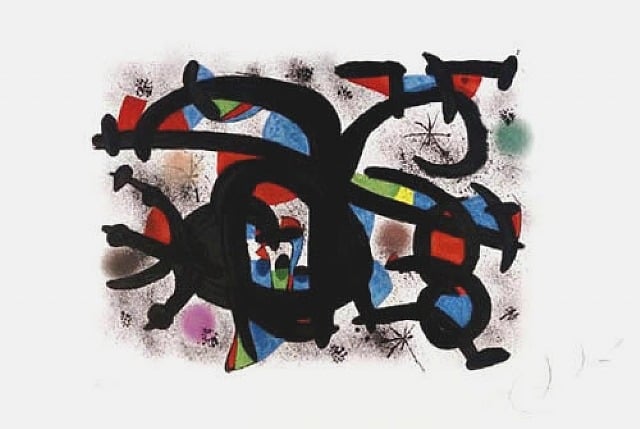
Joan Miró, Le Calin Catalan, lithograph on arches paper, 1981
In 1907, he started business school, but he also managed to take a course in drawing at the School of Fine Arts at La Llotja. While there, he met Ricardo Urgell (Spanish, 1874–1924), who was the first person to identify Miró’s gift. Before he could become a full-time painter, Miró had to convince his reluctant father that he was not made for business. The artist was only able to do so after he had a serious breakdown, which was followed by typhoid fever.
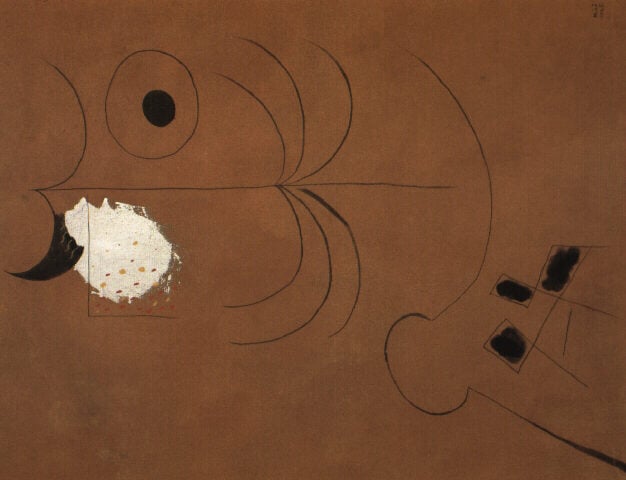
Joan Miró, Le Placeur du music-hall, oil on canvas, 1925
Many consider Miró to be a complex and prolific artist. He created one of his first known paintings, The Peasant, in 1914, and kept working until his death, which was 76 years later. It may be difficult to identify which works are from the artist’s earlier career, because, throughout his lifetime, he continually went back and forth between detail-oriented paintings to highly Figurative ones. It is also very difficult to associate him with one specific art movement, though many categorize him as a Surrealist. Miró is in many ways beyond artistic styles; he mastered the artistic rules established by his own imagination.
According to Miró by Jacques Dupin, the artist was associated with the following movements and artistic periods. In his earliest works, such as Paysage, Mont-roig, one sees an influence from Fauvism, the artistic movement led by Henri Matisse (French, 1869–1954). Some other works from this period bring to mind a kind of Cubism, or more accurately a kind of “Cezannism.”1
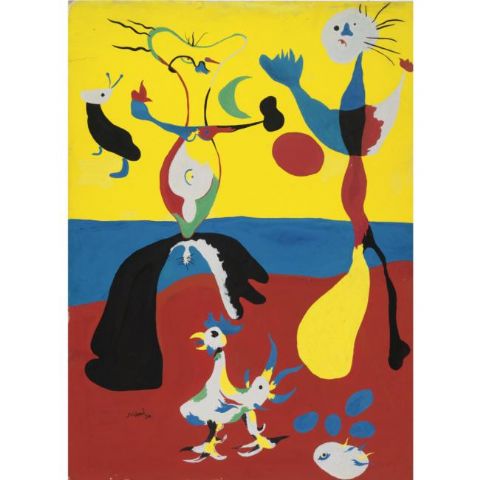
Joan Miró, L’étoile, oil on canvas, 1927
At the very beginning of the 1920s, Miró went to Paris for the first time, and came back to Spain convinced that he would be a pioneer for something completely new within the art world. Nevertheless, his first exhibition did not work out well, and he did not sell a single painting. Back in Mont-roig, he began to work on The Farm. The Realism of this work established him as a talented artist, and gave him the opportunity to later overcome the barriers standing between himself and his genius.
After what Dupin refers to as a “Catalan Fauvism”2 period, Miró began “The Mutation”3 during the years 1923 and 1924. In Paris, he met Dada artists, and progressively nature took a less important role in his works. This served as the artist’s gateway to the Surrealist group. Miró’s first Surrealist painting, Carnival of Harlequin, shows his artistic progress from the time of The Farm. It is still a detail-oriented painting, but this lively composition emerged from his imagination, where inanimate objects, such as a ladder, became alive, with an ear and one eye.
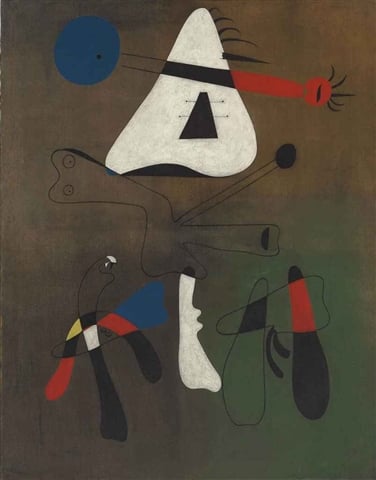
Joan Miró, Peinture, oil on canvas, 1933
Miró’s artistic journey continued as he “managed to break absolutely free of nature,”4 and started to create his “oneiric paintings”5 in 1925 and 1926. In Le Placeur du music-hall, as in every other painting of that period, the background is dominated by one color, which often dominates the composition.
However, by the end of 1926, the painter went back to landscapes, leaving aside the “oneiric paintings”6 to focus on new elements, such as colors, which came back with strength and brilliance like never before. Miró depicted landscapes, such as L’étoile, in great conciseness, at a level that no one else had reached before. The artist used one color for the ground, one color for the sea, and one color for the sky, but yet conveyed the sensation of space.
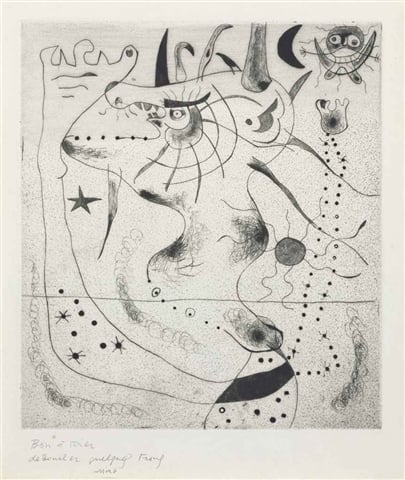
Joan Miró, L’Éveil du Géant, drypoint, 1938
From 1928 to 1931, he entered a phase called “[t]he assassination of painting”7 or “painting anti-painting.”8 Miró faced a personal crisis, and his faith in painting was threatened, perhaps as a late reaction to the Dada movement. At this time, he rejected his own genius and started to give up on colors and painting in general.
In the early 1930s, Miró moved from Paris to Normandy to distance himself from the Surrealist inclination of political commitment and come closer to nature. While there, he discovered a new range of inspirations, and he entered a phase called “Plastic concentration.”9 In 1933, Miró made 18 paintings based on previous collages. These paintings are defined as “organic-abstract,”10 a movement that he led within the Surrealist, inspired by artists such as Hans Arp (French, 1886–1966). The “organic-abstract”11 qualification comes from the fact that, although those works appear to be non-Figurative, observers can find resemblances between the mysterious forms and animals or objects.
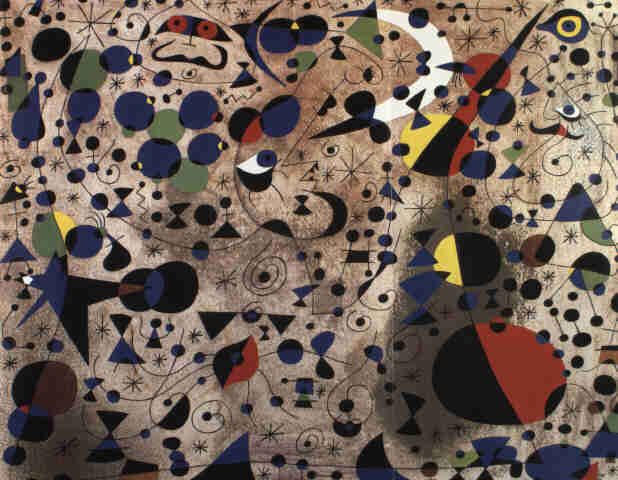
Joan Miró, La poëtesse, gouache, 1940
The war in Spain led Miró to enter a new phase in the year 1934. At this time, the artist created “Savage Paintings.”12 From 1936 to 1939, he was exiled from Spain, and monsters began to appear in his works, such as his Éveil Du Géant.
Gradually, the Normandy landscape had a soothing influence on Miró. While there, he started a new series called Constallations. It resulted in 23 gouaches, made on identical sized canvas and executed in the very same technique. In these compositions, one can see that the artist was influenced by “the moving sky and the flow of constellations and galaxies.”13
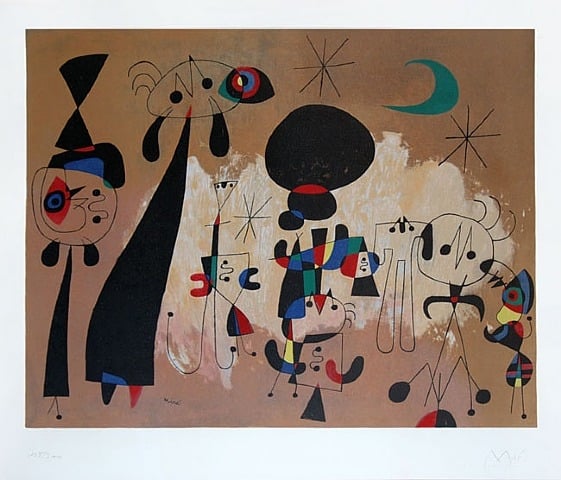
Joan Miró, Woman, Moon, Stars, gouache, 1940
During World War II, he fled from France to Spain and the United States. At this time, the artist created paintings such as Woman, Moon, Stars. He used two techniques: some elements were painted directly on the canvas, but others were first drawn and then colored. In contrast with the white background of his anti-painting crisis, the background once again became one of the most important parts of his work during this period.
Miró’s work soon changed again, but this time not so much because of a change in inspiration, but mostly because of his new studio, designed by the architect Joseph Lluis Sert in Palma de Majorca. The space was enormous, which allowed him to work on bigger compositions. During this period, what required the most time from Miró was not to paint his canvas, but to “think it through.”14 He needed almost 10 months to realize his triptych Blue I, II, III. The effusiveness in his work during the 1920s gave way to an infinitely slow process of intensely reflective creation.
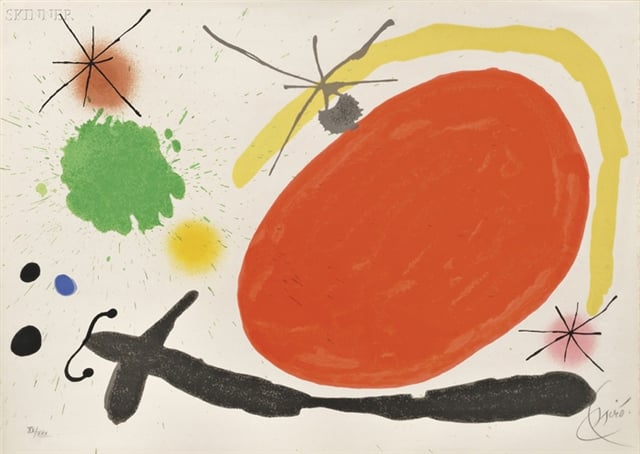
Joan Miró, La Japonaise, color lithograph, 1971
Miró would not have been a great painter without paying a tribute to the Eastern culture. He was always fascinated by Japan and China. In 1924, Miró created a collection of both painting and poetry. After he went to Japan in 1966, he came back once again, influenced by new themes and landscapes, seen in works such as his La Japonaise. At the time, he worked on many paintings at once. From that point on, it became almost impossible to classify his works according to different influences. According to Dupin, “[i]t was as if his works had found their way into a vast and complex delta, where any attempt at chronology no longer holds away.”15 Miró’s works from the same period began to become very different. However, the style of Le Calin Catalan can be found in many artworks during the artist’s last decade.
Last but not least, one cannot introduce Miró without talking about sculpture and poetry. Dupin chose to add them at the end of his biography, because unlike the rest of the artist’s works, they do not really conform to any chronological order. Of course, Miró made Surrealist sculptures, such as Object, which is currently on display in MoMA, or others that can clearly be dated from his anti-painting period, such as his series of Constructions. But his Sun Bird and Moon Bird, which were made in materials such as marble or bronze, are a direct reference to his oneiric period, even though he created them many years afterward. He also made very colorful ceramic sculptures and walls.
In terms of poetry, Miró said himself: “I make no distinction between poetry and painting.”16 He even painted written poems. Most of the time, the sentences were written on top of layers of paintings. The artist loved to play with words in different languages. This can be seen in his work entitled Un oiseau poursuit une abeille et la baisse. If you remove one “s” in the Spanish word “baisse,” you have the French world “baise,” which can mean both kiss and the act of having sex.
Miró was lucky enough to be internationally recognized when he was still alive. Some of his last artworks were made for his foundation, which was established in Barcelona. It is hard to find images of his works there, such as the ceiling inside the hallway, but it is a must-see if you are going to Barcelona!